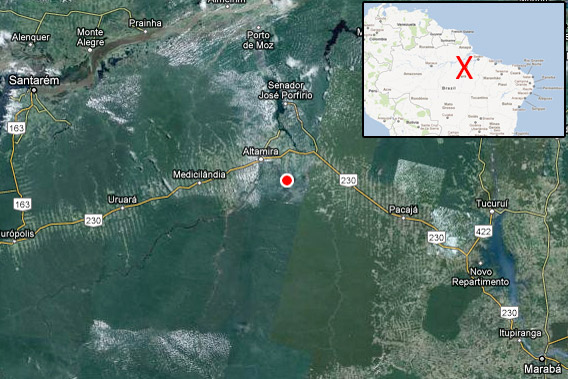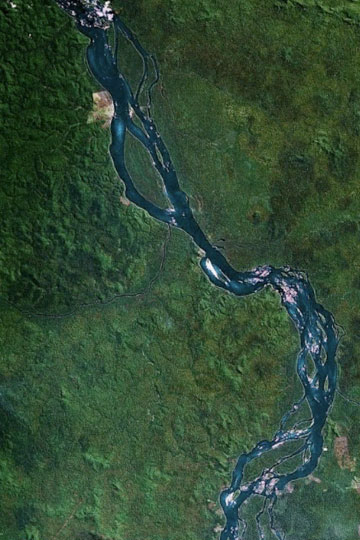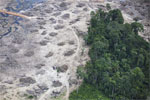| Brazil’s Supreme Court overruled the Federal Appeals Court’s decision on August 28, 2012. Construction resumed the same day. |

Belo Monte location. Courtesy of Google Earth.
A high federal court in Brazil has ruled that work on the Belo Monte dam in the Brazilian Amazon be immediately suspended. Finding that the government failed to properly consult indigenous people on the dam, the ruling is the latest in innumerable twists and turns regarding the massive dam, which was first conceived in the 1970s, and has been widely criticized for its impact on tribal groups in the region and the Amazon environment. In addition the Regional Federal Tribunal (TRF1) found that Brazil’s Environmental Impact Assessment was flawed since it was conducted after work on the dam had already begun.
“The Brazilian Congress must take into account the decisions taken by the indigenous communities. Legislators can only give the go-ahead if the indigenous communities agree with the project,” Judge Souza Prudente told O Globo newspaper, as reported by the BBC.
Construction on the $11 billion dam has been in full swing since earlier this year, prompting a 21-day occupation of the construction site by impacted tribes.
Diverting 80 percent of the flow of the Xingu River, indigenous groups fear the dam will forever change their lives and livelihoods, which depend on the Xingu. The Brazilian government has estimated that 16,000 people will be forced to move, while critics say the number will likely be double that. In addition, the dam will submerge around 40,000 hectares of Amazon rainforest and could decimate some fish populations, possibly even pushing some unique species to extinction.
 A section of the Xingu River as viewed by Google Earth. |
The high court further ruled that Norte Energia, the project consortium building the dam, will face a fine of around $250,000 for every day it continues construction.
Still, observers say this isn’t likely the end of the Belo Monte dam. The hydroelectric project, which if finished would be the world’s third largest, has been suspended several times in the past only to have those suspensions overturned by different judges. Still, experts say it will be more difficult this time around for construction to go ahead.
“The decision on Monday was delivered by the Tribunal Federal Regional that is a higher court than the ones that halted the project before. In addition, this decision is based on constitutional and international law, which didn’t happened in the past,” Astrid Puentes with the Interamerican Association of Environmental Defense (AIDA Americas) told mongabay.com. “With this decision there is even more pressure and more judges that have learned about the case and expressed that Belo Monte is being built in violation of applicable laws.”
Norte Energia has 30 days to appeal, which they are expected to do.
Last year, the Inter-American Commission on Human Rights (IACHR) of the Organization of American States (OAS) requested that Brazil suspend the dam construction also due to what they deemed a lack of consultation with local communities. The request, however, was subsequently ignored by Brazil. But Maíra Irigaray, a lawyer with Amazon Watch, says this decision would prove much more difficult for the government to ignore, because “it’s coming from inside, and it’s a decision made by a group of superior court judges.”
“There would be no excuses for them to [ignore the ruling],” she adds.
So, what’s next for the fight over the Belo Monte dam? Puentes says it will likely head to the Brazil’s Supreme Court.
“What might happen is that the government and Norte Energia (and the consortium), will use all their legal power to fight this at the Supreme Court. In any case, it’s more evident that judges have systematically concluded that Belo Monte was not consulted with communities and it lacks comprehensive environmental impact assessments. Thus the government will have to make serious adjustments if they want to continue with the implementation of [the dam].”
The Brazilian government argues that it needs this dam for power generation. The dam will have an installed capacity of 11,233 megawatts, though critics say it will produce significantly less (up to 90 percent less) than that during much of the year. More dams are planned for the Xingu Basin as well as across the Amazon rainforest.
Related articles
Indigenous tribes end occupation of Belo Monte
(07/12/2012) After occupying the construction site of the massive Belo Monte dam for 21 days, some 300 indigenous people have left and gone home. The representatives from nine Amazonian tribes abandoned their occupation after two days of meeting with the dam’s builder, the Norte Energia consortium.
Indigenous leaders demand suspension of Belo Monte dam
(07/10/2012) Indigenous leaders from six Amazon tribes have asked the Brazilian government to immediately suspend the installation license for the controversial Belo Monte dam, reports Amazon Watch, an activist group that is campaigning against the project.
Brazil’s environmental leadership at risk, warn scientists
(06/26/2012) The Brazilian government is putting its global environmental leadership at risk by ignoring scientific concern on large infrastructure projects and changes in the country’s forest laws, warned an association of more than 1,200 tropical scientists gathering last week in Bonito, Brazil on the heels of the disappointing Rio+20 Earth Summit.
Dams are ‘centerpiece of greenwashing’ in the Amazon
(06/25/2012) Brazil’s ambitious plans to build 30 dams in the Amazon basin could trump the country’s efforts to protect the world’s largest rainforest, said a leading Amazon scientist speaking at the annual meeting of the Association for Tropical Biology and Conservation (ATBC) in Bonito, Brazil.
Photo: Human canvas on Rio beach protests Brazil’s dam-building spree in the Amazon
(06/20/2012) Nearly 1500 people formed a human banner on a beach in Rio de Janeiro today to protest plans to build dozens of dams in the Amazon basin, reports Amazon Watch, an NGO campaigning against Brazil’s controversial Belo Monte dam.
Protesters dig canal through Belo Monte dam in Brazil (Photos)
(06/16/2012) In an symbolic protest of the giant Belo Monte Dam, Friday morning some 300 locals dug a channel in an earthen dam that blocks a portion of the Xingu River and serves as the first step of the controversial hydroelectric project, reports Amazon Watch.
Tropical dams are a false solution to climate change
(05/27/2012) Tropical dams emit considerably more greenhouse gas emissions than their temperate counterparts yet are being treated as a solution to climate change, warns a report published in Nature Climate Change.
Protesters hit Brazilian mining giant Vale over involvement in Belo Monte
(04/20/2012) More than 150 demonstrators protested outside Vale’s headquarters in Rio de Janeiro during the Brazilian mining giant’s annual shareholder meeting over the company’s social and environmental record, reports Amazon Watch, a group that is fighting the massive Belo Monte dam.
Will mega-dams destroy the Amazon?

(04/18/2012) More than 150 new dams planned across the Amazon basin could significantly disrupt the ecological connectivity of the Amazon River to the Andes with substantial impacts for fish populations, nutrient cycling, and the health of Earth’s largest rainforest, warns a comprehensive study published in the journal PLoS ONE. Scouring public data and submitting information requests to governments, researchers Matt Finer of Save America’s Forests and Clinton Jenkins of North Carolina State University documented plans for new dams in Bolivia, Brazil, Colombia, Ecuador, and Peru.
Pictures: Destruction of the Amazon’s Xingu River begins for Belo Monte Dam

(04/18/2012) The Xingu River will never be the same. Construction of Belo Monte Dam has begun in the Brazilian Amazon, as shown by these photos taken by Greenpeace, some of the first images of the hugely controversial project. Indigenous groups have opposed the dam vigorously for decades, fearing that it will upend their way of life. Environmentalists warn that the impacts of the dam—deforestation, methane emissions, and an irreparable changes to the Xingu River’s ecosystem—far outweigh any benefits. The dam, which would be the world’s third largest, is expected to displace 16,000 people according to the government, though some NGOs put the number at 40,000. The dam will flood over 40,000 hectares of pristine rainforest, an area nearly seven times the size of Manhattan.













